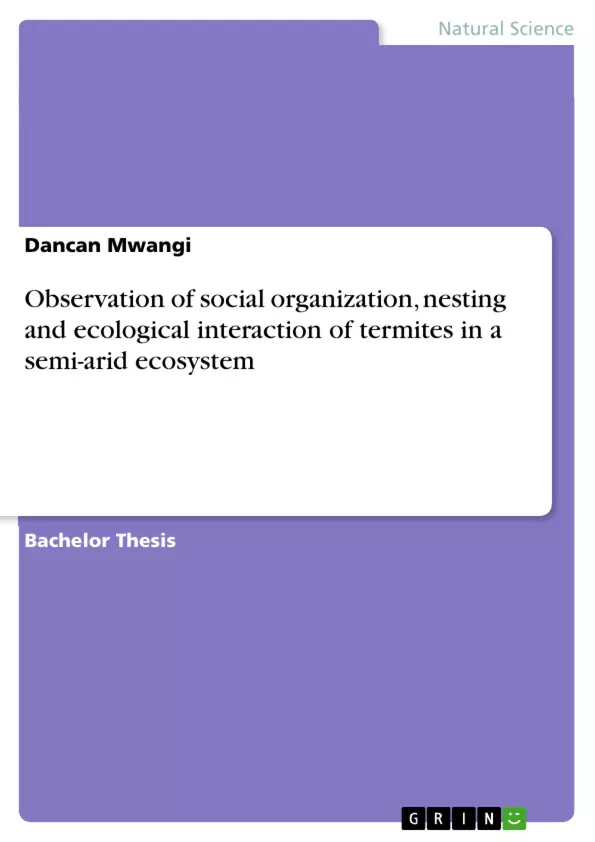Termites are eusosial organisms that have a profile of destructive and menacing organisms that serve an insignificant role in Earth’s ecology complex system. In the semi arid parts of Kenya, they are thought to be the primary cause of vegetation denudation especially during the dry seasons. Even after several years of Biology advancement its uncouth how most people have failed to appreciate the incredible role this animal perform in their niche for the benefit of humanity, especially in the inhospitable arid and infertile environments. Moisture shortage and the elevated temperatures characterize these regions, which has discouraged the survival of many decomposers in this environment leaving only a few species that have adapted to the conditions to survive, notably several species of termites. Water is life; this truth is not lost on these creatures. Some species of termites have evolved to such a level that they have the abilities to forage over unusual long distances and partially control their own dwelling environments, through the construction of nests structures in such a way that humidity and temperature does not vary all seasons. Termites create ingenious nests (mounds) from their waste materials and soils through tightly packing every particle together, creating waterproof corridors. For this reason, many have termed them as soil engineers. The termites’ ability to digest cellulose gives them advantage over other soil macro decomposers. This is enhanced by their mutualistic coexistence with certain bacteria in their gut that enables them to digest cellulose, which is the main constituent of their diet. Overall, Termites are most active soil macro inverts dominating the decomposition process in arid and semi arid environment during the dry seasons.
Table of Contents
- INTRODUCTION AND LITERATURE REVIEW
- 1.1.0 INTRODUCTION
- 1.1.1 Background
- 1.1.3 Objective of the study
- 1.1.4 Hypothesis
- CHAPTER THREE
- 3.1 METHODOLOGY
- 3.1.2 Study site
- 3.1.5.2. Social organization system
- 3.1.5.3. Nesting
- 3.1.5.4. Feeding habits
- 3.1.5.5 Observing vegetation around the mound
- 3.2.1 Materials
- RESULTS AND DISCUSSION
- 4.1 COMPOSITION OF TERMITE GROUPS
- 4.2 SOCIAL ORGANIZATION (workers and soldiers)
- 4.2.1. Reproductive's (queen, king and alates (termite swarmers))
- 4.2.2. Workers
- 4.2.3. Soldiers
- 4.2.4. Diet
- 4.3. Termitogenic structures (Mounds and shelter tubes)
- 4.3.1. Shelter tubes
- 4.4. Mounds
- 4.4.1. Mound occurrence and shape
- 4.4.2. How the mound copes with temperature variation
- 4.3.4. Feeding and foraging
- 4.4.5. Vegetation cover around the mound
- 5.1.1. Decomposition and nutrient cycling
- 5.1.2. Habitat for other organisms and breeding site
- 6.0. Conclusion
- 7.0. Reference
- Social organization and colony structure of termites
- Nesting behavior and the characteristics of termite mounds
- Feeding habits and foraging strategies of termites
- Ecological roles of termites in the semi-arid ecosystem
- The relationship between termites and vegetation in the study area
Objectives and Key Themes
This dissertation aims to investigate the social organization, nesting habits, and ecological interactions of termites in a semi-arid ecosystem. The research focuses on understanding the specific termite species present in the study area, their social structures, nesting behaviors, feeding habits, and their roles in the ecosystem.
Chapter Summaries
The dissertation begins with an introduction that provides background information on termites, their ecological importance, and the specific objectives of the study. It also presents the hypothesis that different termite species will exhibit distinct social organization, nesting behaviors, and feeding habits in the semi-arid ecosystem.
The methodology chapter outlines the methods employed in the research, including the study site selection, data collection techniques, and the specific aspects of termite biology investigated. This section describes the detailed observations made on the social organization, nesting behaviors, and feeding habits of termites, as well as the analysis of the surrounding vegetation.
The results and discussion chapter presents the findings of the study, focusing on the composition of termite groups, their social organization, the characteristics of their mounds and shelter tubes, and their interactions with the surrounding environment. The chapter analyzes the role of termites in decomposition and nutrient cycling, as well as their contribution to providing habitat for other organisms.
Keywords
The research focuses on the social organization, nesting habits, and ecological interactions of termites in a semi-arid ecosystem. Key topics include termite species, social structure, colony dynamics, mound characteristics, feeding habits, and the ecological roles of termites, particularly their influence on decomposition, nutrient cycling, and habitat provision.
- Citar trabajo
- Dancan Mwangi (Autor), 2015, Observation of social organization, nesting and ecological interaction of termites in a semi-arid ecosystem, Múnich, GRIN Verlag, https://www.grin.com/document/294155



